Posted by R. John Howe on 03-26-2003 07:23 AM:
Moghan is Shahsevan
Dear folks –
Congratulations to Bertrand Frauenknecht for a very
detailed and interesting historical salon essay.
The Shahsevan are not my
area of interest and I am, in truth, a relative fledgling with regard to rugs in
general, so I need to be permitted to ask questions of great “innocence,” (to
use a polite expression to describe my real condition).
I understand that
there is no guarantee that things will be simple in the rug world and that the
geographic area under discussion is one of considerable ethnic diversity and
that it was contested by Russia and Iran over the years. So there may often not
be clear answers available (ever) in some areas.
But I was struck by Mr.
Frauenknecht’s indications in the following passage:
“..Influences from
neighbouring people surely have changed designs, as we can see that the southern
Shahsevan produce rugs with different designs than those of the northern
Shahsevan. Take the Afshar Bidjar as an example. It is probably a Kurdish rug
originally, but the Afshar Shahsevan who were neighbours there took the design
over and produced the better quality. To stretch my point, we can talk of a
Shahsevan Gendje or a Shahsevan Shirvan. What is now awaiting our understanding
is that the term Shahsevan is comparable to the term Turkmen, and we can start
by accepting that a Moghan rug is a Shahsevan rug…”
My thought:
I
have heard that many of the better Bidjars were made by Afshar rather than Kurd
weavers, but this is the first time I have heard it claimed that in fact the
better “Afshar” Bidjars were likely made by Shahsevan weavers. I wonder how we
know this and how one recognizes such a weaving.
But it is the last
sentence in this paragraph about which I want to inquire most directly. “…we can
start by accepting that a Moghan rug is a Shahsevan rug…”
Mr.
Frauenknecht provides an instance of a rug that he suggests is properly seen as
Shahsevan, and which has field devices often associated with Moghan
weaving.
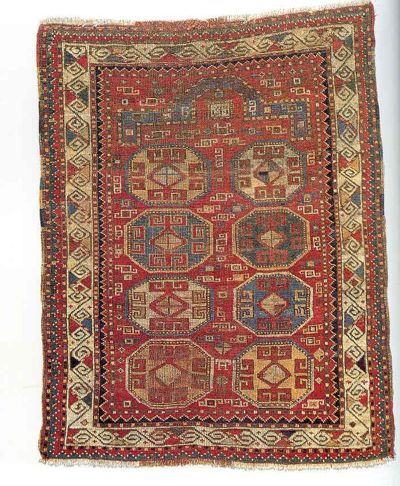
Here, below, is Plate 37 from Kaffel’s “Caucasian Prayer Rugs,”
which he describes, following Lefevre, as “Moghan.”
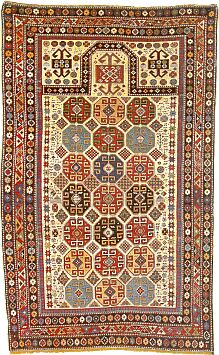
This Kaffel piece has field
“guls” that are similar to the Fraunenknecht piece and the color palette also
seems approximate to me. Mr. Fraunenknecht does not give a technical description
of the piece he presents and neither does Kaffel, but Kaffel seems to accept
Lefevre’s suggestion that this is a piece from a rare Moghan group woven in the
first half of the 19th century.
I once owned, and still know the location
of, a piece nearly identical to Kaffel’s Plate 37. Its guls have slightly less
proportionate height than do those on the Kaffel piece, but its design and color
palette are otherwise identical. I have, of course, had this latter piece in my
hands and can testify that, while I am not sure I can reliably recognize the
line between Moghan and Shirvan weaving, my piece seemed to me rather
classically Shirvan. It has white cotton selvedges, brown and white wool warps
that are not depressed, a color palette that seems to me frequent with weavings
estimated to be Shirvan, border designs that seem Shirvan to me, and a handle
that is similar to that of other Shirvan weavings I have encountered. I asked
Kaffel once about the “Moghan” attribution of Plate 37 and he said frankly that
Lefevre was the only one really claiming that this piece was Moghan.
So
my questions are, what is the basis for Mr. Fauenknecht’s suggestion that the
piece he has provided with similar field guls, is Shahsevan? Does he think,
absent a technical analysis, that we can accept Lefevre’s suggestion that
Kaffel’s Plate 37 is Moghan? If so, does that mean that Plate 37 is actually
properly seen to be a Shahsevan piece? And where would he put my nearly
identically designed and colored piece that seems to me to have some markedly
Shirvan qualities?
Regards,
R. John Howe
Posted by Filiberto Boncompagni on 03-26-2003 08:10 AM:
Hi John,
Both prayer rugs in Bertrand’s Salon are from Kaffel’s
book.
The one you show first is plate 16, the other is plate
21.
Regards,
Filiberto
Posted by Bertram Frauenknecht on 03-26-2003 12:50 PM:
Hello John,
let me start with the "Afshar" Bidjars, I had written Afshar
Shahsevan. You can find this attribution also for Soumacs in Tanavoli. I learned
that in the 70's when I was told in Persia that the best Bidjars are made from
Shahsevan and are called Afshar.
I learned a lot later, that these were
displaced by Nadir Shah in the 18th c.
Thanks Filiberto, I forgot to give
Ralph credit for his wonderful book.
Actually plate 37 has a perfect
Shahsevan border system. The gul like octogons are in many Soumac and reverse
Soumac bags.
I suggest to look at map 1. You'll see the frontiers of the
Khanates being part of the confederacy.
I would call every tribal group in
the Transcaucasus and Azerbaijan Shahsevan when they were Shi'ites and not
original Caucasian people. With very high probability they had joined in the
beginning of and during the 17th century to form a strong and powerful
confederacy.
So it is not really important wether a rug was made in Moghan or
Gendje or Shirwan as long as it carries Shahsevan designs.
Structure is the
next step.
There is no question in my mind that several Shirwan rugs can be
Shahsevan as well.
Here I load some images of typical Shahsevan
designs.
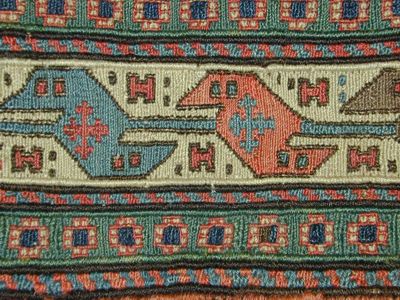
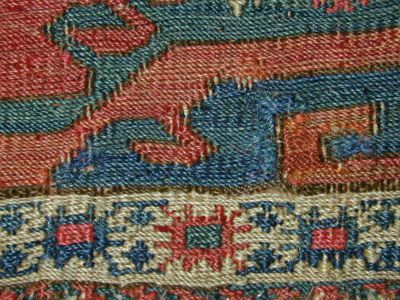
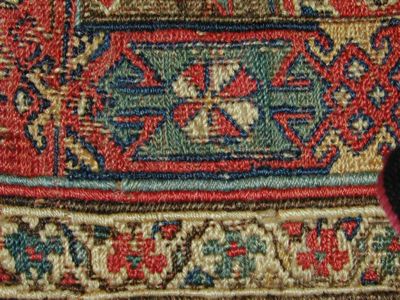
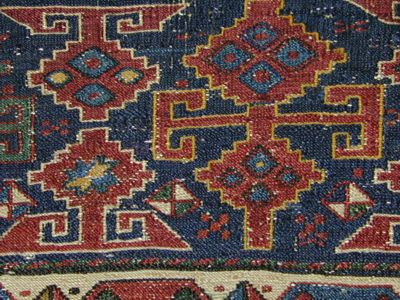
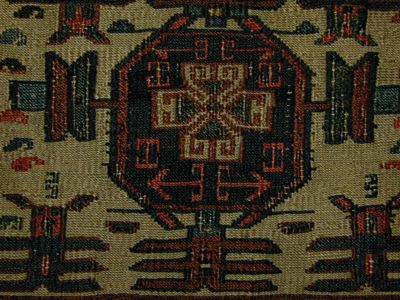
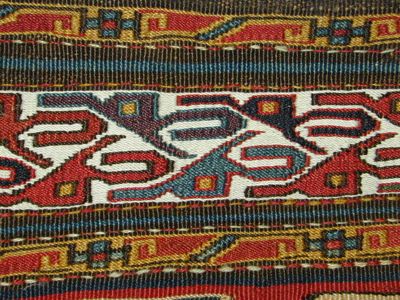
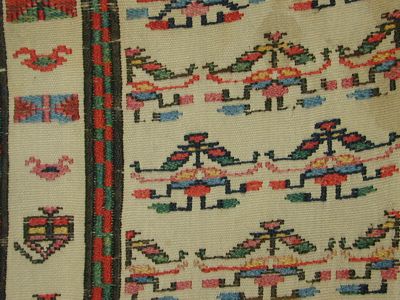
Best
Bertram
Posted by R. John Howe on 03-26-2003 03:50 PM:
Hi Bertram -
Thanks for this additional comment and for the associated
images. Some of these, that you indicate are typically Shahsevan, resonate, at
least for me, with some Turkmen usages.
I refer in particular to the
first image that is informally sometimes called a "bird on a pole" border, to
the border with the double gottchalk and a center rosette, and to the "guls" in
the rugs in Kaffel's Plates 16 and 37. I find that these latter devices resonate
for me with the field guls in Jon Thompson's cover piece on his December 16,
1983 Sotheby's NYC catalog.
Are these similarities simply a reflection
of a broadly used reservoir of "Turkic" usages or is it possible that there are
also Shahsevan-Turkmen weavings or even Turkmen-Shahsevan ones?
Wendel is
going to be very disappointed if this is possible. 
Regards,
R. John Howe
Posted by Bertram Frauenknecht on 03-26-2003 04:02 PM:
hi John,
it's as you say, many of the people came from Anatolia. Families,
groups of Turkmen origin who were not happy with the Ottomans. They took the
chance of more independance and left.
This has happened in the middle ages
everywhere. That's why you have the Amish and that's the Mayflower.
I see a
lot of Turkmen designs in these rugs and flatweaves. If they are
Turkmen?!
Bertram
Posted by R. John Howe on 03-26-2003 08:43 PM:
Hi Bertram -
So you see one major flow of population in this area as
coming from Turkey.
This will provide some vindication for an argument
that Wendel made in a careful paper at ICOC in Philadelphia in which he showed
that the "wine glass and halyx leaf" border in many Caucasian rugs was only half
of a more comprehensive design and that it could be found in Turkish
architecture. P.R.J. Ford, perhaps mostly to lend some spirit to the discussion,
stood up and said that it was a perfectly marvelous presentation but clearly
wrong since it was well known that Caucasian designs were sourced in
Iran.
Not to press too hard, but if you see versions of many of these
designs you offer as also used in Turkish and Turkmen rugs, how can they
function to delineate those that are distinctly
Shahsevan?
Regards,
R. John Howe
Posted by Bertram Frauenknecht on 03-27-2003 07:18 AM:
Hi John,
as I said before, the Shahsevan were not one body or one tribe.
They were rather like a mosaic put together by many different small groups.
Their chiefs declared them as Shahi sevani and so they slowly grew together.
That's why I said that those soumacs must have had a reason, for they don't
exist in any other group or tribe.
Sure there are other soumac weavings, it
is the name of a technique, but the Shahsevan soumacs can not have existed
before. We would have examples from somewhere else.
It is the variety and the
mixture of designs which form a picture specific for these
people.
Interestingly these soumacs were further on made even by displaced
groups. I remember a typical Shahsevan piece with typical Gashgai features. (A
group of S. was send down to the Gashgai region by Nadir)
This mixture of
designs must have been used also in rugs. That's why they look so similar to the
soumacs.
Best
Bertram
Posted by Richard Tomlinson on 03-28-2003 07:26 AM:
confusion reigns....
hello all...
hello bertram...
as a completely unread and
uneducated rug novice, i am finding this fascinating salon difficult to follow.
the way i am reading it is that the 'shahsavan' were thought by many to
be from a distinct geographical region. that is, a rug was either shah or moghun
or shirvan etc.
it appears to me that bertram is now saying that many
rugs considered 'caucasian shirvan' or 'caucasian moghun' or others are in fact
shahsavan. that is, the shah confederecy extended beyond the geographical
boundaries that are considered by many to be 'shahsavan'
is this right?
feel free to shoot me down :-)
but i am VERY confused because bertram
also says;
"Here are three examples of rugs that I believe can properly
be called Shahsevan."
so - is there a "pure" shahsavan rug? are the rest
then 'hybrids'?
if you are confused by what i am asking - join the club
!!
thanks
richard
Posted by Bertram Frauenknecht on 03-28-2003 04:39 PM:
Hello everybody, hello Richard,
it is a bit confusing, as in the past
everybody thought, Shahsevan is a small group of nomads living in the southern
Moghan.
Although several authors had written about S. groups in the areas
between Hashtrud and Veramin nobody took this into consideration. But 'there
must be more to this tribe'. When I stumbled over travelling books with
historical contents it became soon clear to me that Moghan was not this tiny
part we know now, but a huge area with fertile lands and steppe perfect as
grazing land. In the meantime I know that from there these people spread out and
used what they could, which means considering the power their chiefs had with
strong followers behind them, they were very influential in their time.
Even
Tanavoli estimates 800000 members in the late 18th century. This is an enormous
figure considering time and place.
With historical facts a picture forms. The
Shahsevan influence and their people were spread out according to the map you
can study
as map 1. This means to me that their rugs were woven in a much
larger area as we think so far. When we study transcaucasian rugs there are many
which carry designs that we know from soumac bags. Why would the people who
lived there for ages change their designs? They did not . We have many pure rugs
that are clearly belonging into a specific group. But when they carry designs
and symbols which we know from Shahsevan bags then we should at least accept the
possibility that they are rugs from Shahsevan groups.
I don't think that rugs
or bags from our times carry any specific connection to old times. And please
try to get a feeling for the fact that since 1828 the Russians are the masters.
Since ca. 1875
there are synthetic dyes there.
This has changed the
selfunderstanding of these people.
Remember in 1890 their kids went to
highschool!
I'm sorry to say that, but those "Daghestan" bags found in
Mekka
remind me of what I can get in the bazaar in Istanbul as the usual
tourist trash. In 1975 I could still find amongst hundreds of rugs one old
Chamseh in Dshidda. One!
Would anybody believe that the Hadjis are more
stupid than the dealers in Mekka?
You should see the soumacs that the
Shahsevans produce now.
I try to load one
tomorrow.
Best
Bertram









